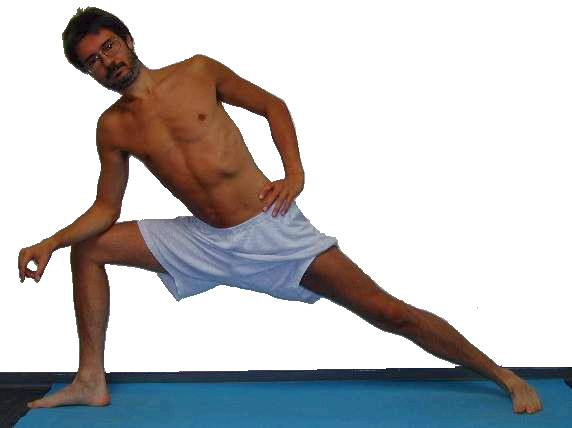Contents
„counter“

 instructions and details with working links as PDF for download/print
instructions and details with working links as PDF for download/print
Feedback: We’d love to hear what you think about this description, give us feedback at:
postmeister@yogabook.org
last update: 12/30/2018
Trivia name: Counter
Level: A
- Classification: A
- Contraindication
- Effects of
- Preparation
- follow-up
- derived asanas
- similar asanas
- diagnostics
- Instruction
- details
- Variants
Classification
classic: standing posture
Contraindication
Effects
- (247) Strengthening the retroverters of the shoulder joint
- (662) Strengthening the rotators of the spine
- (727) Strengthening the monoarticular hip extensors (especially the gluteus maximus)
- (737) Strengthening the exorotators of the hip joint
- (742) Strengthening the abductors
- (812) Strengthening the quadriceps
- (751) Stretching the adductors
Preparation
Follow-up
derived asanas:
similar asanas:
Diagnostics (No.)
Variants:
Instructions
- Take a straddle slightly wider than leg-width.
- Turn the left foot inwards by 20° and turn the right leg on the heel outwards by 90° from the hip joint.
- Keep the pelvis straight and upright in an imaginary plane between the legs and bend the right knee joint until the thigh is horizontal and the lower leg is vertical.
- Tilt the pelvis downwards to the right until you can support yourself with the right forearm on the right thigh.
- Push the right thigh backwards with the forearm without letting the left leg or hip come forward.
- Turn the left side of the upper body backwards and place the left hand on the left hip.
- Do not allow the upper body to move forward but keep the spine over the right thigh.
Details
- This pose is an intermediate pose between warrior 2 pose and parsvakonasana. Depending on your strength and flexibility, either parsvakonasana (in the case of stronger bodies with greater resistance) or the second warrior pose will be perceived as more strenuous and can therefore be held for less time. The counter is another pose in which the adductors can be stretched in a similar way, but the quadriceps of the bending leg can also be strengthened. The counter is closer to parsvakonasana because the pelvis is already in a very similar inclined position and the hip of the stretching leg moves forward accordingly, which is something that we try to avoid at all costs in the second warrior pose. The second warrior stance therefore requires more flexibility in the adductors of the bending leg, more flexibility in the hip flexors on both sides due to the wide abduction and, at the same time, more strength in the bending leg.
- As in the two related postures parsvakonasana and warrior 2 pose,press the outside foot of the extending leg onto the floor, turn the extending leg out to the maximum, extend it fully and move it backwards as far as possible to promote the correct position of the hip of the extending leg. As in the two related postures, the pomus muscles of the bending leg pull the corresponding knee backwards.
- Use the supporting arm topush the leg as far back as possible without allowing the opposite hip to come forward.
- In contrast to parsvakonasana, where it is unavoidable, and in analogy to the 2nd warrior pose, there should be no sideways bending of the upper body at all. Depending on the proportions of the body (especially the length of the upper arm and upper body), this may mean keeping the upper body slightly more upright than the stretching leg.
- Again, both feet push away from each other on the floor using the quadriceps of the bending leg.
- The head is in extension of the thoracic spine and both shoulder blades are in depression and retraction (moved towards the pelvis and spine ).
